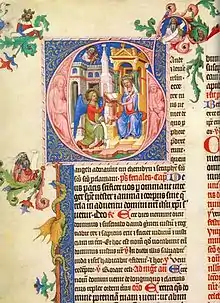Liber viaticus
Liber viaticus is a breviary made sometime in the 1350s, at the latest in 1364, for Bishop John of Neumarkt. This is an illuminated manuscript of 319 sheets in relatively good condition preserved to this day (not the original binding) and deposited in the National Museum Library, Prague (sign. XIII A 12).
 Zvestovani | |
Publication date | 1360s |
|---|---|
| Media type | ink and gouache on parchment |
| Pages | 319 |
| National Museum Library, Prague | |
Analysis
The title Liber viaticus comes directly from the book itself, which in a sort of bookplates is the text "Liber viaticus Domini Johannis, Luthomislensis Episcopi, imperialis cancellarii", which can be translated as "travel book of Mr. John, bishop of Litomysl, superior office". The Codex could therefore serve as a traveling breviary, albeit rather expensive to manufacture at least it raises doubts that he routinely traveled with the book.
The book is especially known for its rich illuminations. The artist (anonymous, in literature known as the Master Liber viaticus), who was well educated; he was familiar with both the Italian and French painting tradition. The Painting concerns several large figure scenes in initials, minor abstract initials, and Drolleries.
Bibliography
External links
| Wikimedia Commons has media related to Liber viaticus. |
- http://www.europeana.eu/portal/record/2063619/CZR_280_003.html
- "Liber viaticus". Projekt Manuscriptorium Digital Library. Retrieved 2016-04-22.